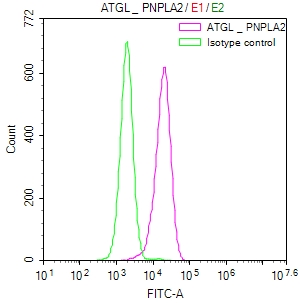A recombinant monoclonal antibody against PNPLA2 was generated through a series of steps, beginning with the immunization of a rabbit using a synthesized peptide derived from human PNPLA2 protein. Subsequently, B cells were isolated from the immunized rabbit, and RNA was extracted from these cells. The extracted RNA was reverse-transcribed into cDNA, which served as a template for extending PNPLA21 antibody genes using degenerate primers. These engineered PNPLA2 antibody genes were incorporated into a plasmid vector and introduced into host cells for expression. The PNPLA2 recombinant monoclonal antibody was then isolated from the cell culture supernatant via affinity chromatography and assessed for its suitability in ELISA and FC applications. It only recognizes human PNPLA2 protein.
PNPLA2/ATGL is a key enzyme involved in the hydrolysis of stored triglycerides, contributing to energy homeostasis, lipid metabolism, and the regulation of adipose tissue function. Its activity is tightly regulated and plays a crucial role in maintaining metabolic health.






